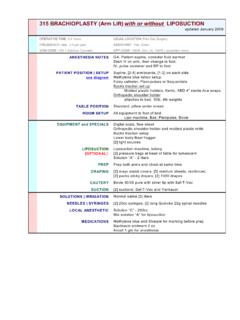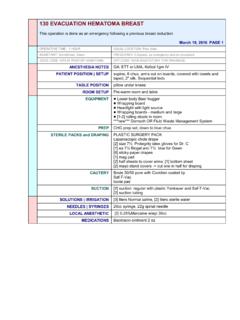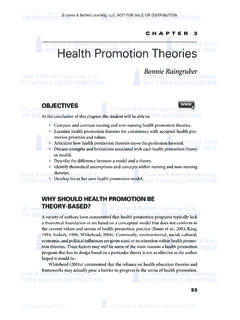Transcription of for Lateral Violence: An Intervention for Teaching ...
1 Teaching Cognitive Rehearsal as a Shield for Lateral violence : An Intervention for Newly Licensed Nurses Martha Griffin, RN, CS, PhD ABSTRACT Background; Recent literature defines Lateral violence as nurses overtly or overtly directing their dissatisfaction inward toward each other, toward themselves, and toward those less powerful than themselves. Newly licensed nurs-es are an identified group that is vulnerable to Lateral vio-lence during theft socialization to nursing practice. The use of cognitive rehearsal, an applied cognitive behavioral technique, was used as an Intervention and the theoretical underpinning for this study Method: Twenty-six newly licensed nurses hired by a large acute care tertiary hospital in Boston, Massachusetts, participated in an exploratory descriptive study They were taught about Lateral violence in nursing practice and the use of cognitive rehearsal techniques as a shield from the neg-ative effects of Lateral violence on learning and socializa-tion.
2 Small laminated cueing cards with written visual cues for the appropriate responses to the most common forms of Lateral ' violence were provided. Ono year later_ videotaped locus groups designed to collect qualitative data about the applied Intervention were conducted. Results: Twenty-six newly licensed nurses in three dif-ferent focus groups were videotaped responding to six open-ended questions designed to elicit information on their experience with Lateral violence , use of cognitive rehearsal as an Intervention , and the overall socialization process. Conclusions; Knowledge of Lateral violence in nursing appeared to allow newly licensed nurses to depersonalize it, thus allowing them to ask questions and continue to learn. The learned cognitive responses helped them con-front the Lateral violence offender, Confrontation was described as difficult but resulted in the resolution of the Lateral violence behavior.
3 Overall, the retention rale in this study population was positively affected_ rrille concept of Lateral violence , also known as hori- zontal violence and more recently called "bullying or aggression," has been discussed in the nursing Liter- ature for almost 2 decades (Farrell, 1997; McKenna, Smith, Poole, & Coverdale, 2002; Roberts, 1983, 1996; Roberts & Chandler, 1996; Smythe, 1984; Street, 1992). Lateral violence in the professional practice of nursing is born out of the construct of nurses being part of an oppressed population. The origins of the theory evolve from the study of oppression in colonized Africans (Fanon, 1963; Freire, 1972; Olcri, 1997). In the United States, a paucity of literature on the prag-rnatics of opera tionalized Lateral violence exists.
4 However, the Dr. Criffin is Program Cpariiinator, Nnrtiag Projes6iorra2 Drmictprnail Departmeni, Brigham & (5 HespiK. Masserchuset!s. Address correiTandence to. Martha' Griffin, RN, C5, PhD, Program Ccordinaior, Nursing Pn*SSisingi DePdOprnetel, B,Figharn & Vvbnien's ilospita, 75 Framers Shiest, Haficior MA .02093. Teaching Cognitive Rehearsal Griffon opposite is true internationally (Duffy, 1995; Freshwater, 2000; Glass, 1997; Hastie, 1995; Leap, 1997; McCall, 1996; McKenna et al., 2003; McMillan, 1995). Agreement exists on what embodies Lateral vio-lence and how it is manifested. Freshwater (2000) reit-erated the connection of Lateral violence in the nursing profession to behaviors of oppressed groups. The inter-group manifestation of conflict is seen in the context of being excluded from the power structure.)
5 "It is contended that because nurses are dominated (and by implication, oppressed) by a patriarchal sys- tem headed by doctors, administrators and marginal- ized nurse managers., nurses lower down the hierar- chy of power resort to aggression among themselves" (Farrell, 1997. p. 482). The body of knowledge grows related to the con-cept of Lateral violence in clinical practice. The overt behavioral manifestations of Lateral violence are expressed by infighting among nurses, withholding pertinent information (sabotage), scapegoeting, criti- 257 cism, and failure to respect confidences and privacy (Duffy, 1995; Farrell, 1997; McCall, 1996). Farrell (1997) described Lateral violence as "professional terrorism" and further cited "eyebrow raising, snide remarks, turning away and withholding information as some of the covert nursing behaviors associated with later-al violence " (p.)
6 504). Although many nurses may not be familiar with the term Lateral violence , they proba-bly have experienced it at some time during their career (Hamlin, 2000). Some victims of Lateral violence in nursing practice, similar to other victims of bully-ing, have resorted to suicide (Hastie, 1995). In an attempt to empirically examine the extent of Lateral violence in nurses' work settings, Farrell (1997) undertook a grounded theory study. Farrell identified three forms of aggression in nursing practice: nurse/patient (or patient/nurse), nurse/family (or family/nurse), and nurse/nurse. His overall findings suggested that the most personally troubling for nurs-es was the nurse/nurse aggression, or professional Lateral violence . Internationally, 1 in 3 nurses leave their position because of Lateral violence or workplace bullies (McMillan, 1995).
7 Usually nurses in the least organizationally power-ful position manifest Lateral violence among them-selves and particularly toward those with the least power (newly hired or newly registered nurses). Further, nurses may be more vulnerable (Farrell, 1997; Freshwater, 2000; Hamlin, 2000). Tolerance for some forms of nursing practice Lateral violence is seen his-torically in the context of a right of passage or expressed in the thought "this is how people were to me, when I was learning." Newly registered nurses face many obstacles to knowledge development and skill acquisition. Today's population of patients are more acute and the staffing patterns often do not allow for downtime or extra support nurses. Job conflict and stress are reported to be the number one problem for new grad-uates in their first year of professional employment (McKenna et al.)
8 , 2003). One of the known reasons that newly registered nurses are more vulnerable is because they have known areas of knowledge need and no past experience as registered nurses, making their work more subject to micro-managing or scruti-ny. Any advancement for a newly licensed nurse, whether to a preferred time schedule or changes in role, is dependent on a clinical peer in a higher power position. In the United States, the annual non-retention (turnover) rate for clinical practicing nurses is 33% to 37%, for newly registered nurses it ranged from 55% to 61 %, and approximately 60% of newly registered nurses leave their first position within 6 months because of some form of Lateral violence perpetrated against them (Beecroft, Kunzrnart, & Krozek, 2001; McKenna, Smith, Poole, & Coverdale, 2003; Winter-Collins & McDaniel, 2000).
9 There are currently no national studies that examine Lateral violence in nurs-ing as an individual form of stress for newly regis-tered nurses. A reduction in attrition rate would not only have a large economic impact, but also., and more important, an impact on nursing practice and profes-sional practice life. CHALLENGE TO THE PROFESSION The challenge to the profession of nursing is to explore these issues and behaviors. Oppressed behav-iors that manifest into Lateral violence in the practice of nursing will not change unless a conscious effort is made to point out the construct to those involved. Methods and mechanisms that interrupt the cycle of Lateral violence can be designed. There is no clear evi-dence that education about Lateral violence is an established part of newly registered nurses' orienta-tion, nor is there any evidence that it is taught in the nursing curriculum (Roberts, 1996).
10 Lateral violence stops newly licensed nurses from asking questions, seeking validation of known knowledge, and feeling like they fit in, and stops them from acquiring the tacit knowledge-build necessary in clinical practice (Sternberg & Horvath, 1999). STRUCTURING AN AWARENESS OF Lateral violence Providing an educational forum on Lateral violence for newly licensed nurses in orientation is essential for raising consciousness. After there is an awareness of this possible impediment to knowledge and skill acquisition, the need for an effective Intervention for newly licensed nurses becomes clear. Cognitive process is the mechanism all individuals use to take in information and structure perceptions of the world (Kaplan & Sadock, 1998). The literature reveals that the negative effects of Lateral violence ( , lowered self-worth, decreased job satisfaction, and stress) can be ameliorated or markedly decreased through edu-cation (Freshwater, 2000; Roberts, 1983).









